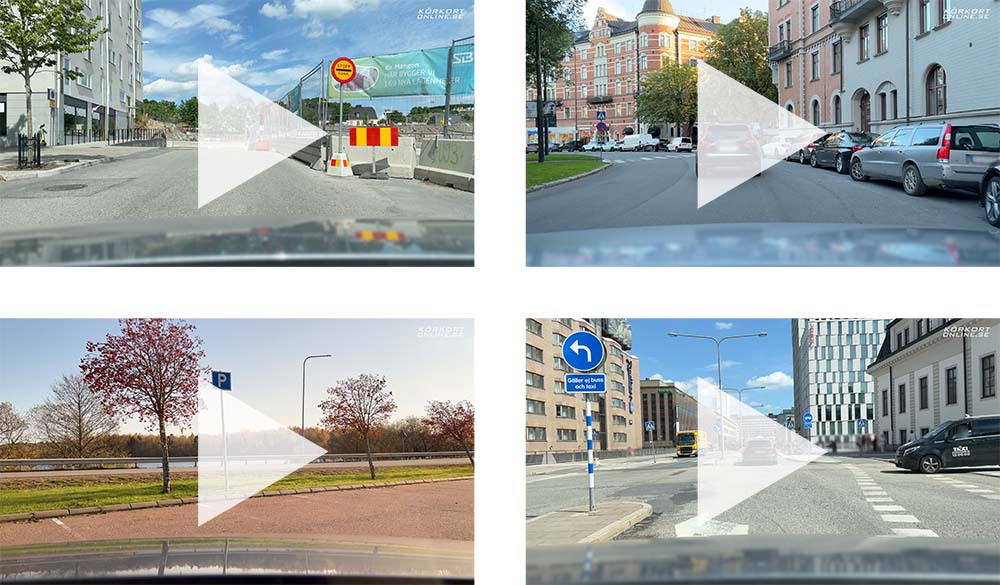Winter & icy roads – risks entailed by winter road conditions
Treacherous road conditions
When there is a lot of snow, most people drive carefully and give themselves greater safety margins. But it is when the slipperiness of the road is not apparent that the most treacherous situations occur.
When the first ice arrives, many people keep driving as if the conditions were the same as on a lovely autumn day. If you are unprepared and enter a curve where there are patches of ice at 90 km/h, it can end very badly.
A treacherous situation is more complex or dangerous than it appears to be:
- A lot of snow and ice = not treacherous, as the danger is evident.
- Patches of ice = treacherous, as the danger is hidden.
Snow tracks
Tracks are formed in the lane where most people drive. You may get good traction inside the tracks, but if you go outside them you may lose the grip on the road completely. You should therefore avoid overtaking in these conditions.
Do you want to overtake the truck? It might be very slippery outside the tyre tracks.
Freezing rain
When the temperature is around 0°C, rain may freeze directly upon contact with the road. This is referred to as freezing rain and it is very dangerous, as you may think it is normal rain, whilst it is actually making the road surface extremely slippery.
Snow smoke
When it gets cold and starts to snow, the car in front of you may trail snow smoke (the tyres whisk up the newly fallen snow). You must therefore maintain an extra large distance to the car in front in this situation.
Broad snowploughing

Use snow markers to assess the width of the road.
In deep snow, you will not see any road markings, which means you have to rely on the tracks of the snowplough. Remember however that the snowplough may have gone outside of the road. If you drive too far to the right, you risk sinking into the snow in the ditch. Snow markers are a good indication of the actual width of the road.
How to discover ice on the road
- Temperature lower than +4°C.
- No splashing heard from under the car, even though the road looks wet/damp. Indicates that the water is frozen.
- At a junction, snow is often densely compressed by passing cars, which increases the risk of ice (the surface of the snow is worn smooth by the tyres).
- Shaded sections of the road that have not been warmed by the sun may have patches of ice.
- Bridges and viaducts have a particularly high risk of ice, as they are cooled by the air from below and above.
Winter equipment

High visibility vest and ice scraper.
Even in very cold temperatures, many people will get in their car and drive off wearing summer clothes. Should you get stuck in a ditch on a forest road, you will soon realise how poorly equipped you are. If you cannot get the car started, the heat will rapidly disappear, and it may take a while for a recovery vehicle to arrive. You should therefore be equipped with the following in winter:
- Warm clothes/shoes.
- Mobile telephone.
- Snow shovel.
- Towline.
- High visibility vest.
- Starter cables.
- Ice scraper.
Things to remember at other times of the year
Winter is the normal time for slippery road conditions. However, the roads can get slippery at other times of the year too. The following are a few examples of things to pay particular attention to in other seasons.

Watch out for wet leaves.
Spring
- In the early spring, the nights can get cold and icy.
- There is a particular risk of ice on shaded sections of the road which have not yet been warmed by the sun.
- Melting snow can also cause problems.
Summer
- On very hot days, the tar in the asphalt may get slippery.
- When it rains after a long period of warm weather, dirt is washed up from the surface of the road. When this happens, the oil remnants can make the road slippery.
Autumn
- Be careful of the first ice that arrives just before winter.
- Dirt dragged onto the road by tractors and combine harvesters can make the road slippery.
- Wet leaves are slippery.
Latest forum posts
- << Special streets
- Winter & icy roads ↑↑
- Road signs >>



